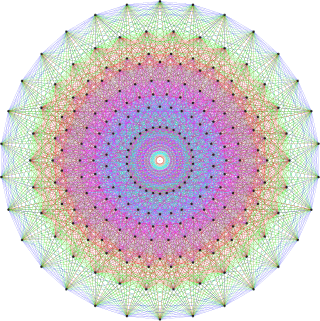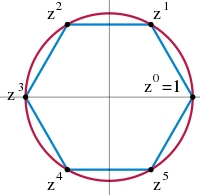Symplectic group
| Group theory → Lie groups Lie groups |
|---|
 |
|
| Algebraic structure → Group theory Group theory |
|---|
 |
|
|
Infinite dimensional Lie group
|
In mathematics, the name symplectic group can refer to two different, but closely related, collections of mathematical groups, denoted Sp(2n, F) and Sp(n), the latter is called the compact symplectic group. Many authors prefer slightly different notations, usually differing by factors of 2. The notation used here is consistent with the size of the matrices used to represent the groups. In Cartan's classification of the simple Lie algebras, the Lie algebra of the complex group Sp(2n, C) is denoted Cn, and Sp(n) is the compact real form of Sp(2n, C). Note that when we refer to the (compact) symplectic group it is implied that we are talking about the collection of (compact) symplectic groups, indexed by their dimension n.
The name "symplectic group" is due to Hermann Weyl (details) as a replacement for the previous confusing names of (line) complex group and Abelian linear group, and is the Greek analog of "complex".
Sp(2n, F)
The symplectic group of degree 2n over a field F, denoted Sp(2n, F), is the group of 2n × 2n symplectic matrices with entries in F, and with the group operation that of matrix multiplication. Since all symplectic matrices have determinant 1, the symplectic group is a subgroup of the special linear group SL(2n, F).
Notational warning: What is here called Sp(2n, F) is often referred to as Sp(n, F).
More abstractly, the symplectic group can be defined as the set of linear transformations of a 2n-dimensional vector space over F that preserve a non-degenerate, skew-symmetric, bilinear form, see classical group for this definition. Such a vector space is called a symplectic vector space. The symplectic group of an abstract symplectic vector space V is also denoted Sp(V).
Typically, the field F is the field of real numbers, R, or complex numbers, C. In this case Sp(2n, F) is a real/complex Lie group of real/complex dimension n(2n + 1). These groups are connected but non-compact.
The center of Sp(2n, F) consists of the matrices I2n and −I2n as long as the characteristic of the field is not 2.[1] Here I2n denotes the 2n × 2n identity matrix. The non-triviality of the center of Sp(2n, F) and its relation to the simplicity of the group is discussed here.
The real rank of the Lie algebra, and hence, the Lie group for Sp(2n, F) is n.
The condition that a symplectic matrix preserves the symplectic form can be written as[2]
where AT is the transpose of A and
The Lie algebra of Sp(2n, F) is given by the set of 2n × 2n matrices A (with entries in F) that satisfy[3]
When n = 1, the symplectic condition on a matrix is satisfied if and only if the determinant is one, so that Sp(2, F) = SL(2, F). For n > 1, there are additional conditions, i.e. Sp(2n, F) is then a proper subgroup of SL(2n, F).
Sp(2n, C)
The symplectic group over the field of complex numbers is a non-compact, simply connected, simple Lie group.
Sp(2n, R)
Sp(2n, C) is the complexification of the real group Sp(2n, R). Sp(2n, R) is a real, non-compact, connected, simple Lie group.[4] It has a fundamental group isomorphic to the group of integers under addition. As the real form of a simple Lie group its Lie algebra is a splittable Lie algebra.
Some further properties of Sp(2n, R):
- The exponential map from the Lie algebra sp(2n, R) to the group Sp(2n, R) is not surjective. However, any element of the group may be generated by the group multiplication of two elements.[5] In other words,
- For all S in Sp(2n, R):
-
.
The matrix D is positive-definite and diagonal. The set of such Zs forms a non-compact subgroup of Sp(2n, R) whereas U(n) forms a compact subgroup. This decomposition is known as 'Euler' or 'Bloch–Messiah' decomposition.[6] Further symplectic matrix properties can be found on that Wikipedia page.
- As a Lie group, Sp(2n, R) has a manifold structure. The manifold for Sp(2n, R) is diffeomorphic to the Cartesian product of the unitary group U(n) with a vector space of dimension n(n+1).[7]
Infinitesimal generators
The members of the symplectic Lie algebra sp(2n, F) are the Hamiltonian matrices.
These are matrices, such that
where B and C are symmetric matrices. See classical group for a derivation.
Example of symplectic matrices
For Sp(2, R), the group of 2 × 2 matrices with determinant 1, the three symplectic (0, 1)-matrices are:[8]
Relationship with symplectic geometry
Symplectic geometry is the study of symplectic manifolds. The tangent space at any point on a symplectic manifold is a symplectic vector space.[9] As noted earlier, structure preserving transformations of a symplectic vector space form a group and this group is Sp(2n, F), depending on the dimension of the space and the field over which it is defined.
A symplectic vector space is itself a symplectic manifold. A transformation under an action of the symplectic group is thus, in a sense, a linearised version of a symplectomorphism which is a more general structure preserving transformation on a symplectic manifold.
Sp(n)
The compact symplectic group[10] Sp(n) is the intersection of Sp(2n, C) with the unitary group:
- .
It is sometimes written as USp(2n). Alternatively, Sp(n) can be described as the subgroup of GL(n, H) (invertible quaternionic matrices) that preserves the standard hermitian form on Hn:
- .
That is, Sp(n) is just the quaternionic unitary group, U(n, H).[11] Indeed, it is sometimes called the hyperunitary group. Also Sp(1) is the group of quaternions of norm 1, equivalent to SU(2) and topologically a 3-sphere S3.
Note that Sp(n) is not a symplectic group in the sense of the previous section—it does not preserve a non-degenerate skew-symmetric (H-bilinear) form on Hn (in fact, the only skew-symmetric form is the zero form). Rather, it is isomorphic to a subgroup of Sp(2n, C), and so does preserve a complex symplectic form in a vector space of dimension twice as high. As explained below, the Lie algebra of Sp(n) is a real form of the complex symplectic Lie algebra sp(2n, C).
Sp(n) is a real Lie group with (real) dimension n(2n + 1). It is compact, connected, and simply connected.[12]
The Lie algebra of Sp(n) is given by the quaternionic skew-Hermitian matrices, the set of n-by-n quaternionic matrices that satisfy
where A† is the conjugate transpose of A (here one takes the quaternionic conjugate). The Lie bracket is given by the commutator.
Important subgroups
The compact symplectic group Sp(n) comes up in quantum physics as a symmetry on Poisson brackets so it is important to understand its subgroups. Some main subgroups are:
Conversely it is itself a subgroup of some other groups:
There are also the isomorphisms of the Lie algebras sp(2) = so(5) and sp(1) = so(3) = su(2).
Relationship between the symplectic groups
Every complex, semisimple Lie algebra has a split real form and a compact real form; the former is called a complexification of the latter two.
The Lie algebra of Sp(2n, C) is semisimple and is denoted sp(2n, C). Its split real form is sp(2n, R) and its compact real form is sp(n). These correspond to the Lie groups Sp(2n, R) and Sp(n) respectively.
The algebras, sp(p, n − p), which are the Lie algebras of Sp(p, n − p), are the indefinite signature equivalent to the compact form.
Physical significance
Classical mechanics
Consider a system of n particles, evolving under Hamilton's equations whose position in phase space at a given time is denoted by the vector of canonical coordinates,
The elements of the group Sp(2n, R) are, in a certain sense, canonical transformations on this vector, i.e. they preserve the form of Hamilton's equations.[13] If
are new canonical coordinates, then, with a dot denoting time derivative,
where
for all t and all z in phase space.[14]
Quantum mechanics
Consider a system of n particles whose quantum state encodes its position and momentum. These coordinates are continuous variables and hence the Hilbert space, in which the state lives, is infinite-dimensional. This often makes the analysis of this situation tricky. An alternative approach is to consider the evolution of the position and momentum operators under the Heisenberg equation in phase space.
Construct a vector of canonical coordinates,
The canonical commutation relation can be expressed simply as
where
and In is the n × n identity matrix.
Many physical situations only require quadratic Hamiltonians, i.e. Hamiltonians of the form
where K is a 2n × 2n real, symmetric matrix. This turns out to be a useful restriction and allows us to rewrite the Heisenberg equation as
The solution to this equation must preserve the canonical commutation relation. It can be shown that the time evolution of this system is equivalent to an action of the real symplectic group, Sp(2n, R), on the phase space.
See also
Notes
- ↑ "Symplectic group", Encyclopedia of Mathematics Retrieved on 13 December 2014.
- ↑ Hall 2015 Eqn (1.9)
- ↑ Hall 2015 Prop. 3.25
- ↑ "Is the symplectic group Sp(2n, R) simple?", Stack Exchange Retrieved on 14 December 2014.
- ↑ "Is the exponential map for Sp(2n, R) surjective?", Stack Exchange Retrieved on 5 December 2014.
- ↑ "Standard forms and entanglement engineering of multimode Gaussian states under local operations – Serafini and Adesso", Retrieved on 30 January 2015.
- ↑ "Symplectic Geometry – Arnol'd and Givental", Retrieved on 30 January 2015.
- ↑ Symplectic Group, (source: Wolfram MathWorld), downloaded February 14, 2012
- ↑ "Lecture Notes – Lecture 2: Symplectic reduction", Retrieved on 30 January 2015.
- ↑ Hall 2015 Section 1.2.8
- ↑ Hall 2015 p. 14
- ↑ Hall 2015 Prop. 13.12
- ↑ Arnold 1989 gives an extensive mathematical overview of classical mechanics. See chapter 8 for symplectic manifolds.
- ↑ Goldstein 1980, Section 9.3
References
- Arnold, V. I. (1989), Mathematical Methods of Classical Mechanics, Graduate Texts in Mathematics, 60 (second ed.), Springer-Verlag, ISBN 0-387-96890-3
- Hall, Brian C. (2015), Lie groups, Lie algebras, and representations: An elementary introduction, Graduate Texts in Mathematics, 222 (2nd ed.), Springer, ISBN 978-3319134666
- Fulton, W.; Harris, J. (1991), Representation Theory, A first Course, Graduate Texts in Mathematics, 129, Springer-Verlag, ISBN 978-0-387-97495-8 .
- Goldstein, H. (1980) [1950]. "Chapter 7". Classical Mechanics (2nd ed.). Reading MA: Addison-Wesley. ISBN 0-201-02918-9.
- Lee, J. M. (2003), Introduction to Smooth manifolds, Graduate Texts in Mathematics, 218, Springer-Verlag, ISBN 0-387-95448-1
- Rossmann, Wulf (2002), Lie Groups – An Introduction Through Linear Groups, Oxford Graduate Texts in Mathematics, Oxford Science Publications, ISBN 0 19 859683 9
- Ferraro, Alessandro; Olivares, Stefano; Paris, Matteo G. A. (March 2005), Gaussian states in continuous variable quantum information, arXiv.org, arXiv:quant-ph/0503237, Bibcode:2005quant.ph..3237F .